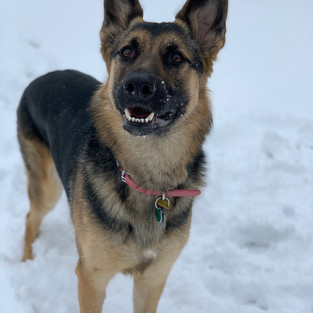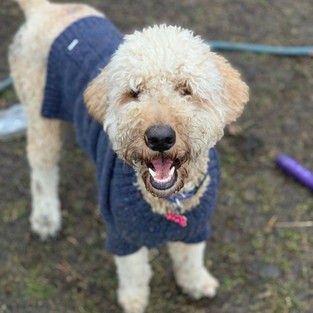Doggo-to-Hooman Affection
- Mama SaMammals

- Feb 12, 2020
- 4 min read
Updated: May 27, 2020
As Valentine’s Day is this week, I figured it would be appropriate to talk about something that makes us all warm and fuzzy inside, and that is how dogs show affection to humans and one another. There is no better feeling than coming home to your canine companion wiggling with excitement and overflowing with pure, unadulterated love. Each individual animal has their own way of showing affection, and it’s important to be able to interpret and understand dogs’ body language in order to determine if he/she is being friendly and affectionate or standoffish and possibly even aggressive.
One of the more obvious signs of affection is tail wagging. However, just because a dog is wagging its tail doesn’t mean it is okay to approach him/her. It’s crucial to your safety to be able to carefully read and interpret the many different messages dogs send with their body language, particularly with their tails. What you want to look for is the height and position of the tail, the speed of wagging, and what the rest of the body is doing. For example, if a dog’s tail is between its legs it’s probably scared or anxious about something it perceives as a threat. If a dog is holding its tail straight up and stiff, wagging in rapid and tiny motions, it’s a clear sign not to approach them, because they may react aggressively.
A friendly dog who is happy to see you will wag with its entire body, especially the tail and booty area. Their tail will wag in big, sweeping circles, and if they don’t have tails, you’ll be able to tell by the way they excitedly wiggle their hips. Australian Shepherds, like Breck, for example, are notorious for wiggling their butts like crazy when they are happy and/or excited, which is practically all the time. Here’s a video of our Boxer friend Bobo demonstrating is wiggle butt in action, and let me tell you, these hips don’t lie!
Another way dogs show affection is by their facial expressions. Do not mistake panting for smiling. Panting is a natural way for dogs to cool off the body after a vigorous play session, but it can also be a sign of distress. A happy dog will actually smile with its mouth slightly open and/or give you the adorable puppy eyes that melt your heart. Dogs communicate affection with their eyes when they make eye contact with us in a loving way with a soft, round, adoring gaze.
On the contrary, when you see a dog that is standing stiff and tall, leaning forward and staring with hard, cold eyes, know it is not safe to approach them. If a dog looks up at you with squinty eyes, it’s often a sign of appeasement, which signifies a friendly, social disposition. However, pay close attention to the rest of the dog’s body language, because squinty eyes don’t always mean it’s okay to approach. If a dog is squinting at you with his body posture stiff, back, and lowered, it is probably a sign of fear, which can lead to aggression.

Be aware of “whale eyes,” where the eyes are wide you can see more than the usual amount of white in a dog’s eyes, which often signals stress and fear. However, when dogs are at play, they may widen their eyes quite a bit, but it is out of pure excitement and joy. As long as you pay attention to a dog’s overall body language in addition to its facial expression, you should be able to interpret and understand what they are feeling. Pictured her one of our teammate's dogs, Maddon, demonstrating "whale eyes."
One of the rather cute but annoying ways dogs show affection is by jumping. While we may think it’s cute when a tiny puppy jumps up on its hind legs and wiggles its little body all around, it’s significantly less cute once they grow into a full blown animal. Not all people are dog lovers, and even those who are may not like to be jumped on. Dogs jump in order to get closer to your face in order to give you a big, sloppy, “welcome home, friend!” lick, meaning they love you!
While we may think it’s cute when a tiny puppy jumps up on its hind legs and wiggles its little body all around, it’s significantly less cute once they grow into a full-blown animal. Not all people are dog lovers, and even those who are may not like to be jumped on. Dogs jump in order to get closer to your face in order to give you a big, sloppy, “welcome home, friend!” lick, meaning they love you!
Sometimes dogs jump on humans for other reasons, like if they struggle with separation anxiety and are overwhelmed with relief when their humans come home. Another reason dogs may jump is to exhibit dominance. If a dog jumps up and boinks you hard in the face with their muzzle, this is aggressive behavior and needs to be stopped. It’s important to be aware of the difference between frantic jumping and happy-camper jumping, and train your dog not to jump up on strangers so as to avoid any alarming encounters.
When we think about affection, leaning hardly comes to mind for most people. However, leaning is a big way that dogs show their affection. When a dog leans into you, it means they trust you and feel secure. Some say that dogs lean as a way of showing dominance, but there is no scientific proof, and many animal care professionals have spoken up about the inaccuracies of this claim. More often than not, it’s the large dogs that love to lean. For example, two of my regular daycare dogs, Pearl, a Great Dane, and Nala, a German Shepherd-Lab mix, are notorious for leaning into my legs.
On the note of dogs being pack-oriented mammals, it’s important to recognize their need for social companionship with other dogs. Next time, we’ll be discussing how dogs show affection to one another. Have questions or are interested in a certain topic? Howl or yowl at us in the comments! Thanks for reading!

































Comments